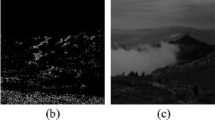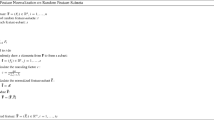Abstract
Spatial rich model (SRM) is a classic steganalysis method, which collects high-order co-occurrences from truncated noise residuals as feature to capture the local-range dependencies of an image. Increasing the truncation threshold and the co-occurrence order will lead to a higher-dimensional feature, which can exploit more statistical bins and capture dependencies across larger-range neighborhood, but this will suffer from the curse of dimensionality. In this paper, we propose a fast projection method to increase the statistical robustness of the higher-dimensional SRM feature while decreasing its dimensionality. The proposed projection method is applicable to co-occurrence-based steganalysis features. The detection performance and the computational complexity of the proposed method are investigated on three content-adaptive steganographic algorithms in spatial domain.



Similar content being viewed by others
References
Avcibas I, Memon ND, Sankur B (2001) Steganalysis using image quality metrics. In: Delp EJ, Wong PW (eds) SPIE, electronic imaging, security and watermarking of multimedia contents III, San Jose, vol 4341, pp 523–531
Bas P, Filler T, Pevný T (2011) Break our steganographic system—the ins and outs of organizing boss. In: Filler T, Pevný T, Ker A, Craver S (eds) 13th international conference of information hiding. Lecture notes in computer science, Prague, vol 6958, pp 59–70
Bingham E, Mannila H (2001) Random projection in dimensionality reduction: applications to image and text data. In: Knowledge discovery and data mining. ACM Press, New York. pp 245–250
Böhme R (2010) Advanced statistical steganalysis. Springer, Berlin
Botta M, Cavagnino D, Pomponiu V (2015) Fragile watermarking using Karhunen–Loéve transform: the KLT-F approach. Soft Comput 19(7):1905–1919
Breiman L (1996) Bagging predictors. Mach Learn 24:123–140
Castiglione A, Bonaventura D, DeSantis A (2011a) Steganography and secure communication on online social networks and online photo sharing. In: 2011 international conference on broadband, wireless computing, communication and applications, pp 363–368. doi:10.1109/BWCCA.2011.60
Castiglione A, Bonaventura D, DeSantis A, Palmieri F (2011b) New steganographic techniques for the OOXML file format. In: IFIP international federation for information processing 2011 (ARES’11). LNCS 6908, vol 4. Springer, Berlin, pp 344–358. doi:10.1007/978-3-642-23300-5_27
Castiglione A, DeSantis A, Fiore U, Palmieri F (2011c) E-mail-based covert channels for asynchronous message steganography. In: International conference on innovative mobile and internet services in ubiquitous computing. IEEE, pp 503–508. doi:10.1109/IMIS.2011.133
Castiglione A, DeSantis A, Fiore U, Palmieri F (2012) An asynchronous covert channel using spam. Comput Math Appl 63(2):437–447. doi:10.1016/j.camwa.2011.07.068
Cox IJ, Kilian J, Leighton FT, Shamoon T (1997) Secure spread spectrum watermarking for multimedia. IEEE Trans Image Process 6(12):1673–1687
Cox IJ, Miller ML, Bloom JA, Fridrich J, Kalker T (2008) Digital watermarking and steganography, 2nd edn. Morgan Kaufmann Publisher, San Francisco
Denemark T, Fridrich J, Holub V (2014a) Further study on the security of s-uniward. In: Proceedings of SPIE—the international society for optical engineering, vol 9028. doi:10.1117/12.2044803
Denemark T, Sedighi V, Holub V, Cogranne R, Fridrich J (2014b) Selection-channel-aware rich model for steganalysis of digital images. In: Proc. of IEEE international workshop on information forensics and security, pp 48–53
Filler T, Fridrich J (2010) Gibbs construction in steganography. IEEE Trans Inf Forensics Secur. 5(4):705–720. http://www.ws.binghamton.edu/fridrich/Research/gibbs-construction10.pdf. Accessed 22 Dec 2013
Filler T, Judas J, Fridrich J (2011) Minimizing additive distortion in steganography using syndrometrellis codes. IEEE Trans Inf Forensics Secur 6(3):920–935
Fridrich J, Kodovský J (2012) Rich models for steganalysis of digital images. IEEE Trans Inf Forensics Secur 7(3):868–882. http://dde.binghamton.edu/kodovsky/pdf/TIFS2012-SRM.pdf. Accessed 22 Dec 2013
Fu Z, Sun X, Liu Y, Liu B (2012) Text split-based steganography in OOXML format documents for covert communication. Secur Commun Netw 5(9):957–968
Goljan M, Fridrich J (2015) Cfa-aware features for steganalysis of color images. In: SPIE 9409, media watermarking, security, and forensics 2015 SPIE electronic imaging international society for optics and photonics, vol 94090V. doi:10.1117/12.2078399
Goljan M, Fridrich J, Cogranne R (2014) Rich model for steganalysis of color images. In: IEEE workshop on information forensic and security, Atlanta
Holub V, Fridrich J (2012) Designing steganographic distortion using directional filters. In: Fourth IEEE international workshop on information forensics and security, Tenerife, pp 234–239
Holub V, Fridrich J (2013a) Digital image steganography using universal distortion. In: Puech W, Chaumont M, Dittmann J, Campisi P (eds) Proceedings of the first ACM workshop on information hiding and multimedia security. France, Montpellier, pp 59–68
Holub V, Fridrich J (2013b) Random projections of residuals for digital image steganalysis. IEEE Trans Inf Forensics Secur 8(12):1996–2006
Holub V, Fridrich J (2015) Low complexity features for jpeg steganalysis using undecimated DCT. IEEE Trans Inf Forensics Secur 10(2):219–228
Huang F, Huang J, Shi YQ (2012) New channel selection rule for jpeg steganography. IEEE Trans Inf Forensics Secur 7(4):1181–1191
Ker AD (2014) Implementing the projected spatial rich features on a GPU. Media Watermarking Secur Forensics 9028(2):96–101
Kodovský J, Fridrich J, Holub V (2012) Ensemble classifiers for steganalysis of digital media. IEEE Trans Inf Forensics Secur 7(2):432–444
Lyu S, Farid H (2002) Detecting hidden messages using higher order statistics and support vector machines. In: 5th international workshop on information hiding. Lecture notes in computer science, vol 2578, pp 340–354
Lyu S, Farid H (2006) Steganalysis using higher-order image statistics. IEEE Trans Inf Forensics Secur 1(1):111–119. doi:10.1109/TIFS.2005.863485
Mansoori EG (2013) GACH: a grid-based algorithm for hierarchical clustering of high-dimensional data. Soft Comput 18(5):1–18
Matsui K, Tanaka K (1994) Video-steganography: how to secretly embed a signature in a picture. In: IMA intellectual property project proceedings
Pevný T, Bas P, Fridrich J (2010) Steganalysis by subtractive pixel adjacency matrix. IEEE Trans Inf Forensics Secur 5(2):215–224
Rahimi A, Benjamin R (2008) Random features for large-scale kernel machines. In: Platt J, Koller D, Singer Y, Roweis S (eds) Advances in Neural Information Processing Systems 20, Curran Associates, Inc., pp 1177–1184. http://papers.nips.cc/paper/3182-random-features-for-large-scale-kernel-machines.pdf. Accessed 10 Feb 2015
Wang P, Wei Z, Xiao L (2015) Pure spatial rich model features for digital image steganalysis. Multimed Tools Appl. doi:10.1007/s11042-015-2521-9
Zamani M, Abdul MAB, Abdullah SM (2012) An overview on audio steganography techniques. Int J Digit Content Technol Appl 6:107–122
Zhu X, He C, Li K, Qin X (2012) Adaptive energy-efficient scheduling for real-time tasks on DVS-enabled heterogeneous clusters. J Parallel Distrib Comput 72(6):751–763
Zou D, Shi YQ, Su W, Xuan G (2006) Steganalysis based on markov model of thresholded prediction-error image. In: Proceedings IEEE, international conference on multimedia and expo, Toronto, pp 1365–1368
Acknowledgments
The authors would like to thank the Network Center of Anhui University of Technology (AHUT) for providing cloud services to support this work.
Author information
Authors and Affiliations
Corresponding author
Ethics declarations
Funding
This study was funded by National Natural Science Foundation of China (Grant Nos. 61302178, 61105020), Foundation for Major Program of Education Bureau of Anhui Province (Grant No. KJ2015ZD09) and Excellent Youth Foundation of Anhui University of Technology (Grant No. z10097).
Conflict of interest
All the authors and the Network Center of Anhui University of Technology declare that they have no conflict of interest.
Ethical approval
This article does not contain any studies with human participants or animals performed by any of the authors.
Additional information
Communicated by V. Loia.
Rights and permissions
About this article
Cite this article
Wang, P., Wei, Z. & Xiao, L. Fast projections of spatial rich model feature for digital image steganalysis. Soft Comput 21, 3335–3343 (2017). https://doi.org/10.1007/s00500-015-2011-z
Published:
Issue Date:
DOI: https://doi.org/10.1007/s00500-015-2011-z




